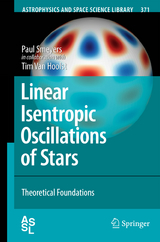Linear Isentropic Oscillations of Stars
Springer Berlin (Verlag)
978-3-642-13029-8 (ISBN)
Basic Concepts.- The Equations Governing Linear Perturbations in a Quasi-Static Star.- Deviations from the Hydrostatic and Thermal Equilibrium in a Quasi-Static Star.- Eigenvalue Problem of the Linear, Isentropic Normal Modes in a Quasi-Static Star.- Spheroidal and Toroidal Normal Modes.- Determination of Spheroidal Normal Modes: Mathematical Aspects.- The Eulerian Perturbation of the Gravitational Potential.- The Variational Principle of Hamilton.- Radial Propagation of Waves.- Classification of the Spheroidal Normal Modes.- Classification of the Spheroidal Normal Modes (continued).- Completeness of the Linear, Isentropic Normal Modes.- N 2(r) Nowhere Negative as Condition for Non-Radial Modes with Real Eigenfrequencies.- Asymptotic Representation of Low-Degree, Higher-Order p-Modes.- Asymptotic Representation of Low-Degree and Intermediate-Degree p-Modes.- Asymptotic Representation of Low-Degree, Higher-Order g +-Modes in Stars Containing a Convective Core.- Asymptotic Representationof Low-Degree, Higher-Order g +-Modes in Stars Consisting of a Radiative Core and a Convective Envelope.- High-Degree, Low-Order Modes.- Period Changes in a Rapidly Evolving Pulsating Star.
| Erscheint lt. Verlag | 25.11.2010 |
|---|---|
| Reihe/Serie | Astrophysics and Space Science Library |
| Zusatzinfo | XIV, 473 p. |
| Verlagsort | Berlin |
| Sprache | englisch |
| Maße | 155 x 235 mm |
| Gewicht | 888 g |
| Themenwelt | Naturwissenschaften ► Physik / Astronomie ► Angewandte Physik |
| Naturwissenschaften ► Physik / Astronomie ► Astronomie / Astrophysik | |
| Technik ► Luft- / Raumfahrttechnik | |
| Schlagworte | Asteroseismology • cepheids • Convective core • giant stars • g-modes • Helioseismology • isentropic normal modes • p-modes • quasi-static-star • solar-type stars • Star • Stellar • stellar normal modes • Stellar oscillations • Stellar pulsations |
| ISBN-10 | 3-642-13029-1 / 3642130291 |
| ISBN-13 | 978-3-642-13029-8 / 9783642130298 |
| Zustand | Neuware |
| Haben Sie eine Frage zum Produkt? |
aus dem Bereich




